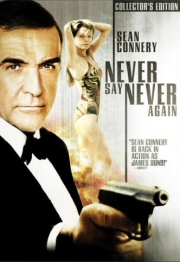- Rated PG
- Action
- 1983
- Buy the DVD
Reviewed by Ross Ruediger
()
ften viewed as the ugly stepchild of the James Bond movies, “Never Say Never Again” may be the most polarizing movie to feature the martini-swilling superspy (unless, of course, one counts the ‘67 spoof “Casino Royale” – but really, who would?). But can a Bond movie starring Sean Connery ever really be that bad? It depends who you ask. While this re-release isn’t exactly brimming with extras, there’s just enough on here to give some insight into a production about which most people (myself included) are largely ignorant.
The movie is usually described as “a remake of ‘Thunderball’,” which isn’t quite the truth. As it turns out, the one thing producer Jack Schwartzman (the late husband of Talia Shire, as well as father of Jason the actor and John the cinematographer) was basically forbidden to do was remake “Thunderball.” Due to legalities too complex to elaborate on here, the producers were instead allowed only to work from Ian Fleming’s original text to create their version of this story. Pretty much anything created for the previous movie that wasn’t in the book was off limits.
This in and of itself makes the movie a curiosity piece, as it’s the only time in Bond film history that we’ve gotten two different versions of the same Fleming story (again, let’s not bring the “Casino” spoof into the equation). The final product really doesn’t bear much resemblance to the ‘65 outing. It features some of the iconography and many character names are the same or similar, but otherwise it might as well just be another James Bond movie (especially when one considers how similar all the movies in the franchise are to one another.) Further, “Thunderball” is actually a pretty boring movie, and while many a criticism may be launched at “Never Say Never Again,” boring probably wouldn’t be the first word used to describe it.
Perhaps the most important similarity to “Thunderball” is the core plot, which centers on two stolen nuclear bombs and SPECTRE’s scheme to hold the world at ransom, which is such a ‘60s conceit that it admittedly, along with the idea of SPECTRE itself, feels very out of place in the ‘80s. But that doesn’t stop the production team from charging ahead as if it’s a perfectly reasonable setup. (Thank goodness Austin Powers hadn’t yet arrived on the movie scene.) Bond (Connery) is called out of retirement to tackle the situation, and along the way he visits a countryside health spa, the Bahamas, and finally the Middle East. His enemies include the sexually charged yet lethal Fatima Blush (Barbara Carrera) and the power-hungry and clearly sociopathic Maximillian Largo (Klaus Maria Brandauer), while he receives help from the CIA in the form of Felix Leiter (Bernie Casey) and romances Domino Petachi (Kim Basinger in her first high profile movie role), who also happens to be Largo’s girlfriend. See, like I said, this could be any James Bond movie.
To that end, what’s particularly noteworthy is that director Irvin Kershner (fresh off “The Empire Strikes Back”), who’s a very vocal presence on this DVD, doesn’t appear to have a lot of love for James Bond movies, and it seems that his aim was to get as far away from the jokey, gadget-driven formula as possible. But regardless of intent, the Bond formula just wouldn’t allow for too much of a departure, because “Never Say Never Again” really isn’t much more than the structure of the ‘60s Connery outings fused with the sensibilities of the ‘80s Roger Moore era. There’s no way anyone would ever mistake it for anything other than a Bond flick. And for a Bond flick to succeed (in the pre-Daniel Craig era, anyway), all the elements must congeal in a way that’s both fresh and familiar. While “Never Say Never Again” is more hit than miss, its misses may be far more glaring than its hits are prominent.
On the miss side is Basinger’s Domino, who, while always stunning to look at, never amounts to much more than a damsel in distress, until (spoiler alert!), inexplicably, she shows up in scuba gear armed with a harpoon to kill Largo in the film’s limp underwater climax. Much like “Thunderball,” this movie’s underwater sequences aren’t terribly exciting (save for an excellent shark attack on Bond in the second act); thankfully, though, they are kept to a minimum, as Kershner admits to a disliking for underwater inaction. The now infamously bad video game battle between Largo and Bond manages to get worse every year this film exists, so given that this movie is now 26 years old, you can only imagine how dated the scene looks. The tango sequence between Bond and Domino that follows isn’t much better. Also a minor blip of a failure is Edward Fox’s portrayal of M, who comes across as little more than a cartoonish stiff upper lip, rather than Bond’s superior and a boss with which to be reckoned. Finally there’s the music, which wallows in early ‘80s excess and completely fails to locate the timeless target, which is always the mark of a good Bond score. Personally, I have a nostalgic admiration for such movie music, so it doesn’t bother me, yet I’d be remiss not to mention that it’s likely to annoy many who see this for the first time.
At the top of the hit list, however, is Barbara Carrera, who absolutely chews her way through the picture. You simply cannot take your eyes off of her any time she’s onscreen, and she emerges as one of the all-time great Bond villainesses. Trailing not too far behind her is Brandauer’s Largo, who is perhaps the movie’s boldest creation in that he’s just so far off the Bond villain radar. There’s nothing even remotely campy or over the top about the guy – he’s just a psychotic businessman with a foolproof plan that only fails to take Bond into account (indeed, a clichéd ‘60s leftover in the third act sees Largo chaining Bond to a wall to die, only so that he can escape moments later). But Brandauer has a delicious field day with the role, and it’s only misguided belief in himself that eventually proves to be his undoing
The film’s photography is pretty slick and the stuff in the Bahamas in particular has aged very well. Further, the movie simply moves. Even when it’s stumbling, it’s still an entertaining flick, and the storyline is streamlined enough that it never feels as convoluted as some of the other movies in the series. It’s got just the right amount of elements to keep it stealthily headed toward the unfortunately weak ending mentioned above. It’s also got Rowan Atkinson, as the amusingly named Nigel Small-Fawcett, which is a great addition for those of us who worship at the altar of all things Rowan.
Finally there’s Connery, without whom this movie would be an all but forgotten footnote in Bond film history (and it’s very likely the movie would’ve been made with another actor if Connery hadn’t stepped up to the plate). Despite all the positives previously listed, the real reason this movie works is because of Connery, who, just like Bond in the film, came out of 007 retirement to play what’s still his most famous role one more time. His work here can’t really be described in terms of “it’s as if he’d never even left the role.” It had been 12 years since his last outing, “Diamonds are Forever,” and a lot had changed in that time, and well, the ‘70s had zipped by. His sexist, manhandling take on the character would hardly be appropriate for 1983. So this version of Connery’s Bond is considerably lighter, and one wonders if – even though Connery would likely never admit to it – Moore’s take on Bond influenced Connery’s portrayal here.
In any case, he’s just so damn at ease in this film, and undeniably he’s the glue holding the entire affair together. Even though this Bond is played as aged and retired, Connery is actually three years younger than Moore, meaning that the elder Moore was still playing Bond in his prime in “Octopussy,” which was also released in ‘83 – and the less said about Moore in 1985’s “A View to a Kill,” the better. For the record, I’m a huge Moore fan, and actually prefer his Bond to Connery’s, but right before the end credits roll, there’s the now iconic line that echoes the film’s title, and you can’t help but wish Connery would’ve returned just once more.
Collector's Edition DVD Review:
This disc is a welcome double-dip, given that the previous edition was barebones (in fact, it even omitted a lengthy sequence of the film). Don’t expect the same treatment the official series has been given, but at least some work has been put into it. An audio commentary with Kershner and Bond historian Steven Jay Rubin works about half the time. When Kershner is recollecting specific incidents from filming, or discussing behind the scenes gossip, it’s actually quite good. But just as often he delves into the dreaded “let me describe for you what’s happening onscreen” small talk that commentary aficionados loathe. Further, the guy always sounds like he’s yelling. Three featurettes, which probably could’ve been edited into a single, longer doc, are again nicely informative and go a long way towards showing what a clusterfuck it was to make this movie. There’s a number of noteworthy voices chiming in, including Talia Shire(!), but if you’re expecting to see Connery or even Basinger, you’ll be disappointed. Finally there’s a trailer and a photo gallery.
You can follow us on Twitter and Facebook for content updates. Also, sign up for our email list for weekly updates and check us out on Google+ as well.












